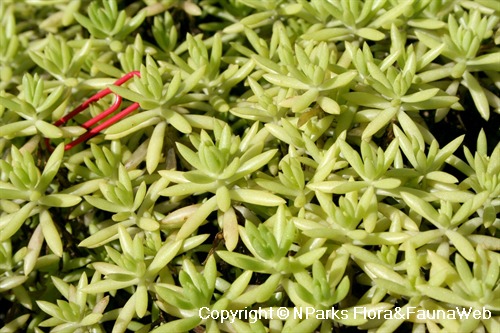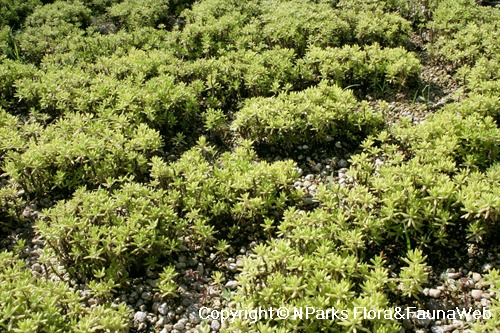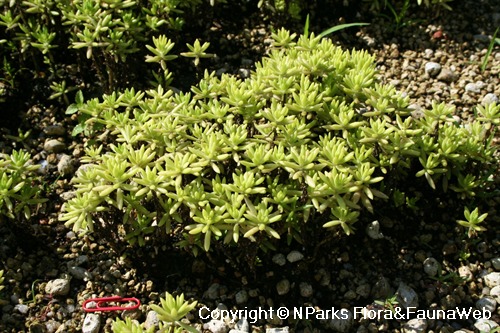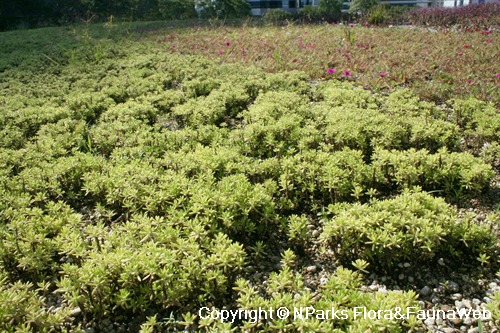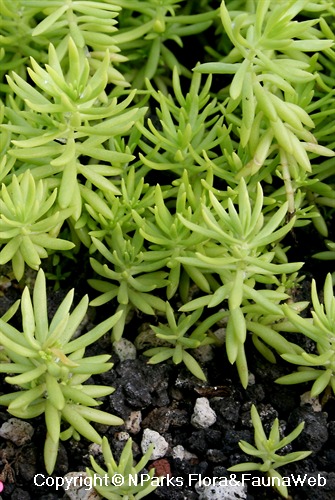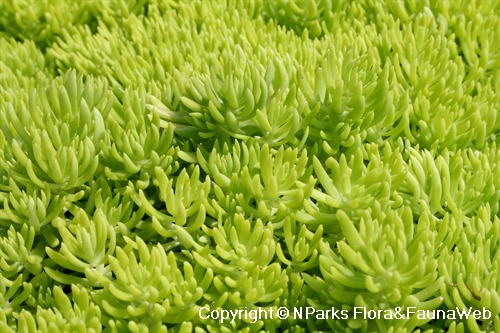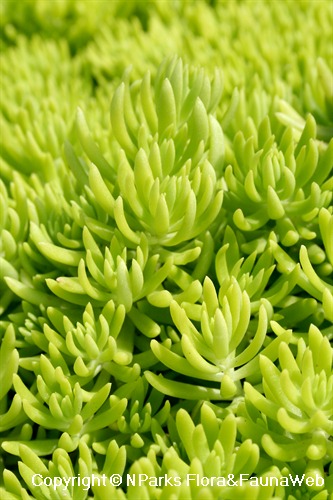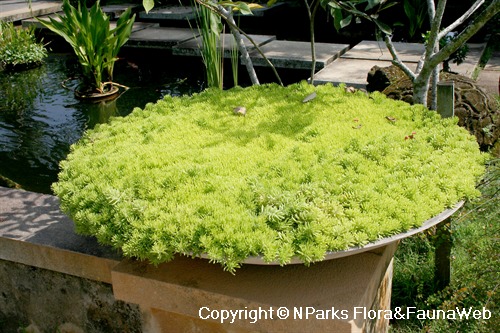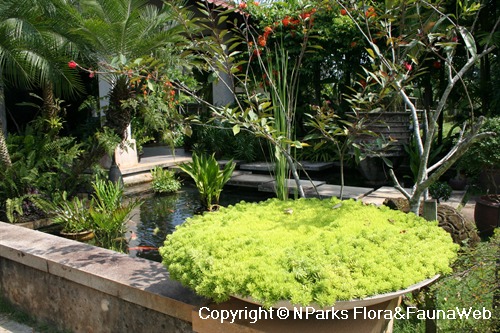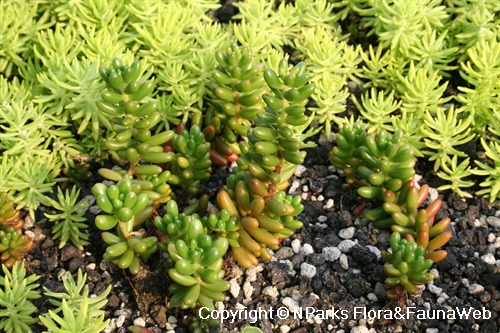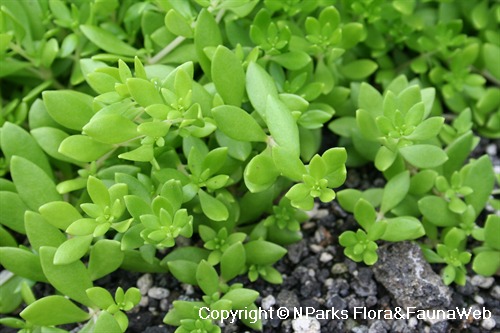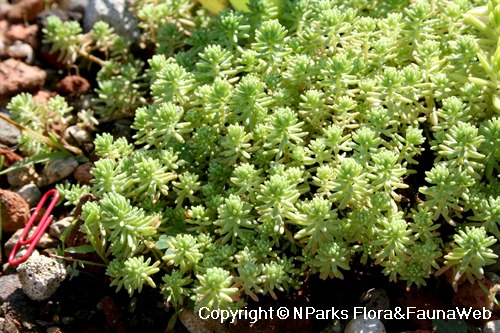
Back
Sedum mexicanum Britton
| Family Name: | Crassulaceae |
| Synonyms: | Sedum obtusolineare |
| Common Name: | Mexican Sedum, Mexican Stonecrop, 松叶佛甲草 |
Name
Classifications and Characteristics
| Plant Division | Angiosperms (Flowering Seed Plants) (Dicotyledon) |
|---|---|
| Plant Growth Form | Creeper, Herbaceous Plant |
| Lifespan (in Singapore) | Perennial |
| Mode of Nutrition | Autotrophic |
| Plant Shape | Dwarf |
| Maximum Height | 0.05 m to 0.10 m |
| Maximum Plant Spread / Crown Width | 0.4 m |
Biogeography
| Native Distribution | Mexico |
|---|---|
| Preferred Climate Zone | Tropical |
Description and Ethnobotany
| Growth Form | Herbaceous succulent sub-shrub, generally upright in habit but creeps to form dense mats of up 10cm height. |
|---|---|
| Foliage | Leaves bright green, linear and needle-like, fleshy, arranged in whorls of 4 - 5 around stems. |
| Flowers | Golden yellow with orange-red anthers, produced as large flat cymes on long scorpioid branching stalks, not observed in Singapore. |
| Fruit | Explosive follicles with numerous tiny seeds (0.7 mm), not produced in Singapore. |
| Cultivation | Prefers well-drained soils. Easily propagated by stem cuttings or leaf cuttings. |
| Etymology | Genus epithet 'Sedum' derived from Latin for 'sit', a reference to how some species of this genus grow attached to rocks and walls. Species epithet 'mexicanum' refers to its purported origins in Mexico, although the plant's exact native habitat is unknown. Thought by some botanists to be of Oriental or Chinese origin, due to resemblance to similar-looking but less upright Oriental species like Sedum lineare. Plant is commonly grown and has escaped from cultivation in many Central American countries. |
Landscaping Features
| Desirable Plant Features | Ornamental Foliage |
|---|---|
| Landscape Uses | Suitable for Rooftops, Container Planting, Flowerbed / Border |
| Thematic Landscaping | Golden Garden, Rockery / Desert Garden |
Fauna, Pollination and Dispersal
| Seed or Spore Dispersal | Abiotic (Explosive Dehiscence), Biotic (Fauna) |
|---|
Plant Care and Propagation
| Light Preference | Semi-Shade, Full Sun |
|---|---|
| Water Preference | Little Water |
| Plant Growth Rate | Fast |
| Rootzone Tolerance | Well-Drained Soils, Poor Infertile Soils, Shallow Media, Easy to Grow, Disease / Pest Resistant, Drought Tolerant |
| Maintenance Requirements | Moderate |
| Propagation Method | Seed, Stem Cutting, Leaf Cutting |
Foliar
| Foliage Retention | Evergreen |
|---|---|
| Mature Foliage Colour(s) | Green |
| Mature Foliage Texture(s) | Smooth, Thick |
| Foliar Type | Simple / Unifoliate |
| Foliar Arrangement Along Stem | Whorled, Spiral |
| Foliar Shape(s) | Non-Palm Foliage (Linear) |
| Foliar Margin | Entire |
| Foliar Apex - Tip | Acuminate |
| Typical Foliar Area | Microphyll ( 2.25cm2 - 20.25 cm2 ) |
| Leaf Area Index (LAI) for Green Plot Ratio | 4.5 (Shrub & Groundcover - Dicot) |
Non - Foliar and Storage
| Stem Type & Modification | Herbaceous |
|---|---|
| Root Type | Underground (Fibrous Root) |
| Specialised Storage Organ(s) | Aboveground |
Floral (Angiosperm)
| Flower & Plant Sexuality | Bisexual Flowers |
| Flower Colour(s) | Yellow / Golden |
|---|---|
| Flower Symmetry | Radial |
| Flower Size - Remarks | Small |
| Inflorescence Type | Cyme |
| Flowering Habit | Polycarpic |
| Flowering Period Remarks | Flowers in summer in seasonal climates. Not observed to flower in Singapore. |
Fruit, Seed and Spore
| Fruit Classification | Simple Fruit |
|---|---|
| Fruit Type | Dehiscent Dry Fruit , Follicle |
Image Repository
Others
| Master ID | 1152 |
|---|---|
| Species ID | 2445 |
| Flora Disclaimer | The information in this website has been compiled from reliable sources, such as reference works on medicinal plants. It is not a substitute for medical advice or treatment and NParks does not purport to provide any medical advice. Readers should always consult his/her physician before using or consuming a plant for medicinal purposes. |

